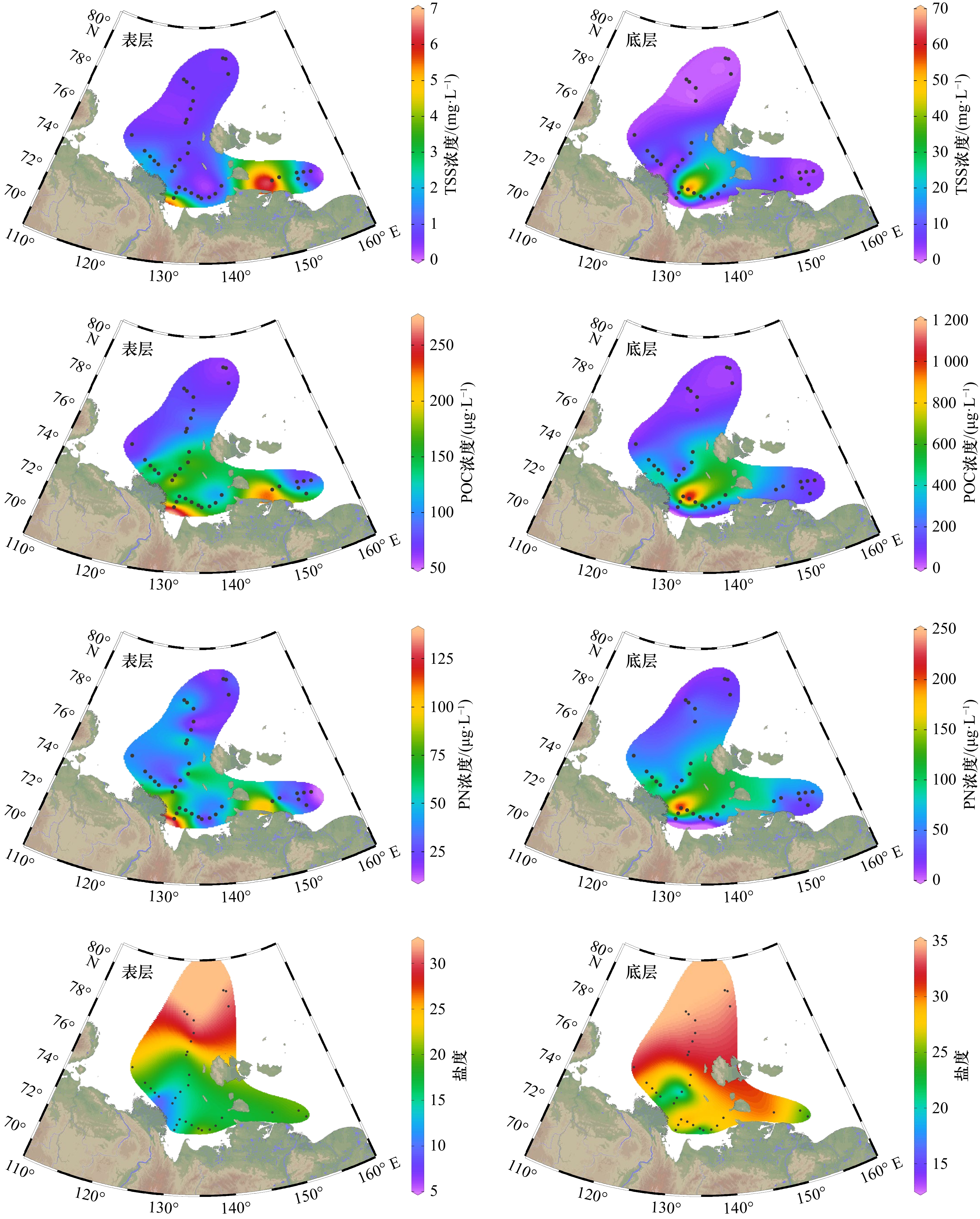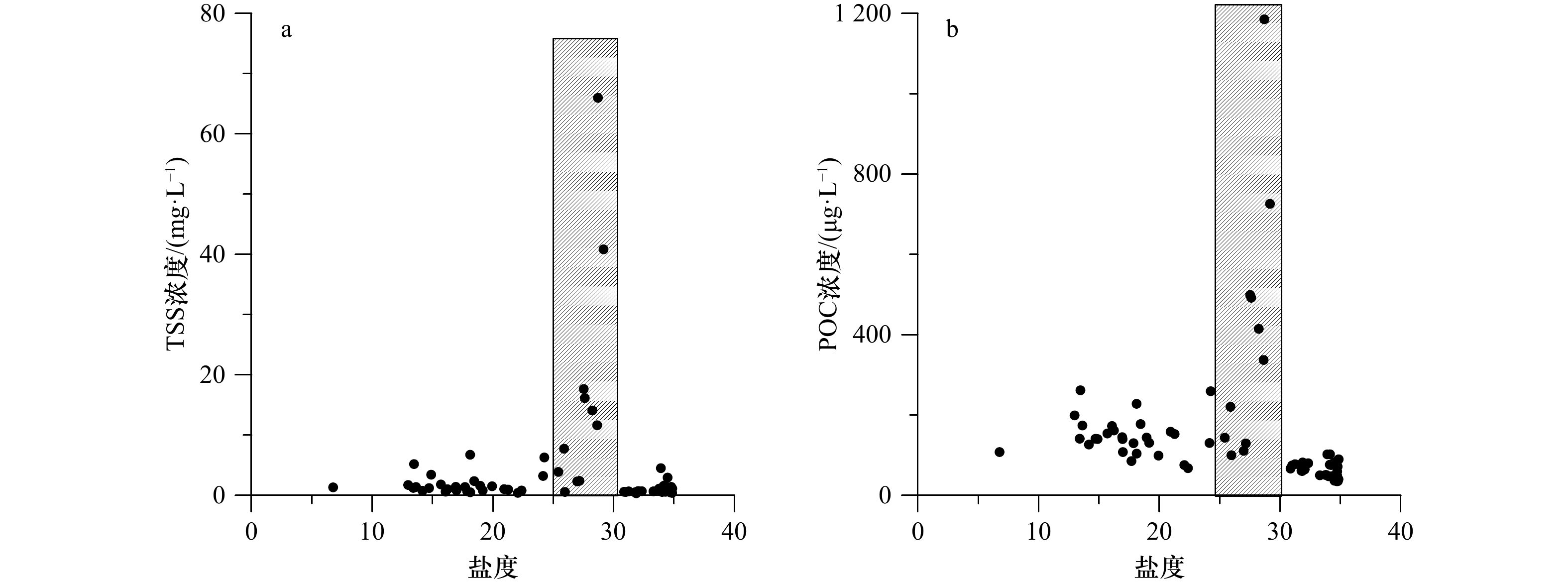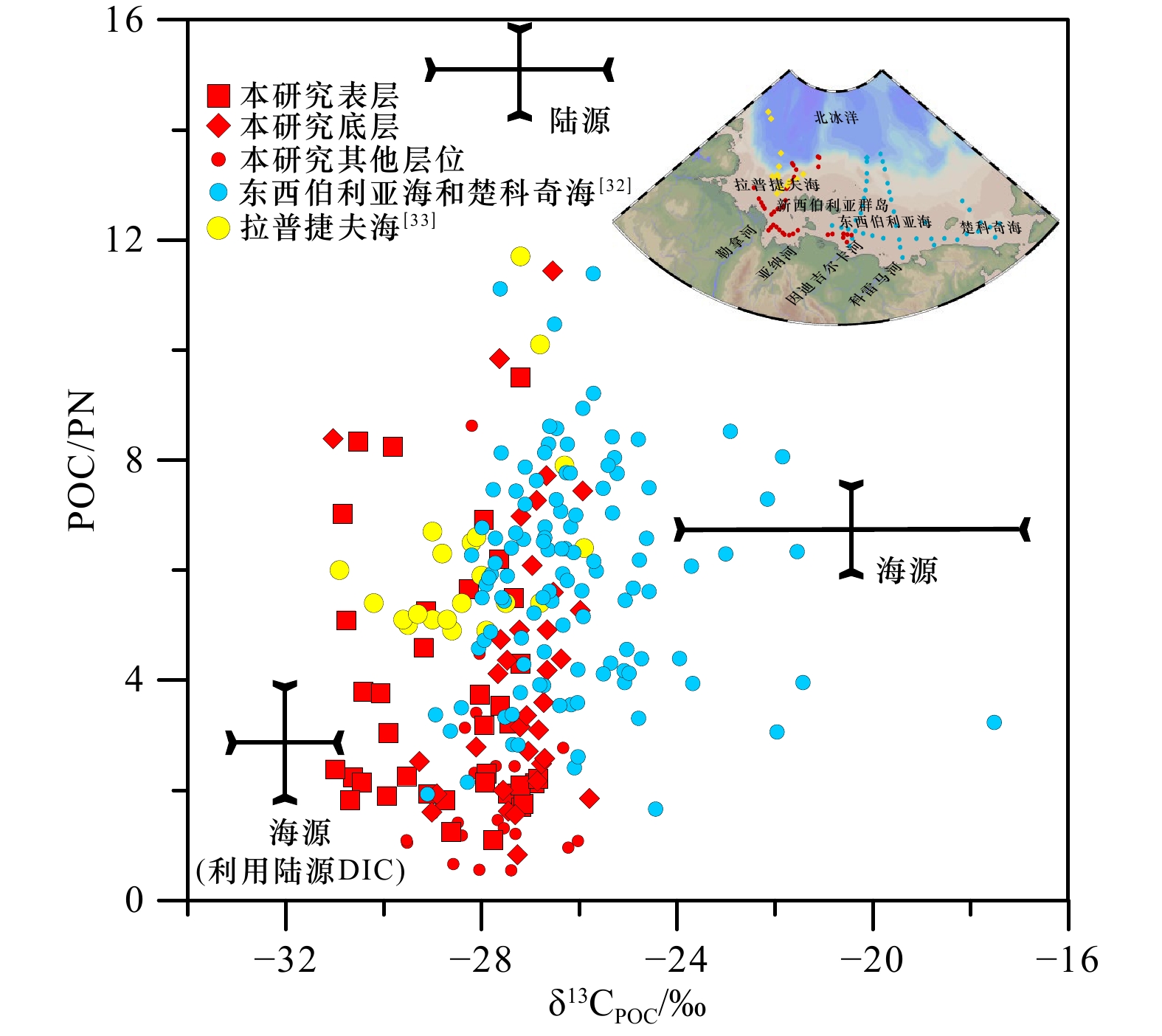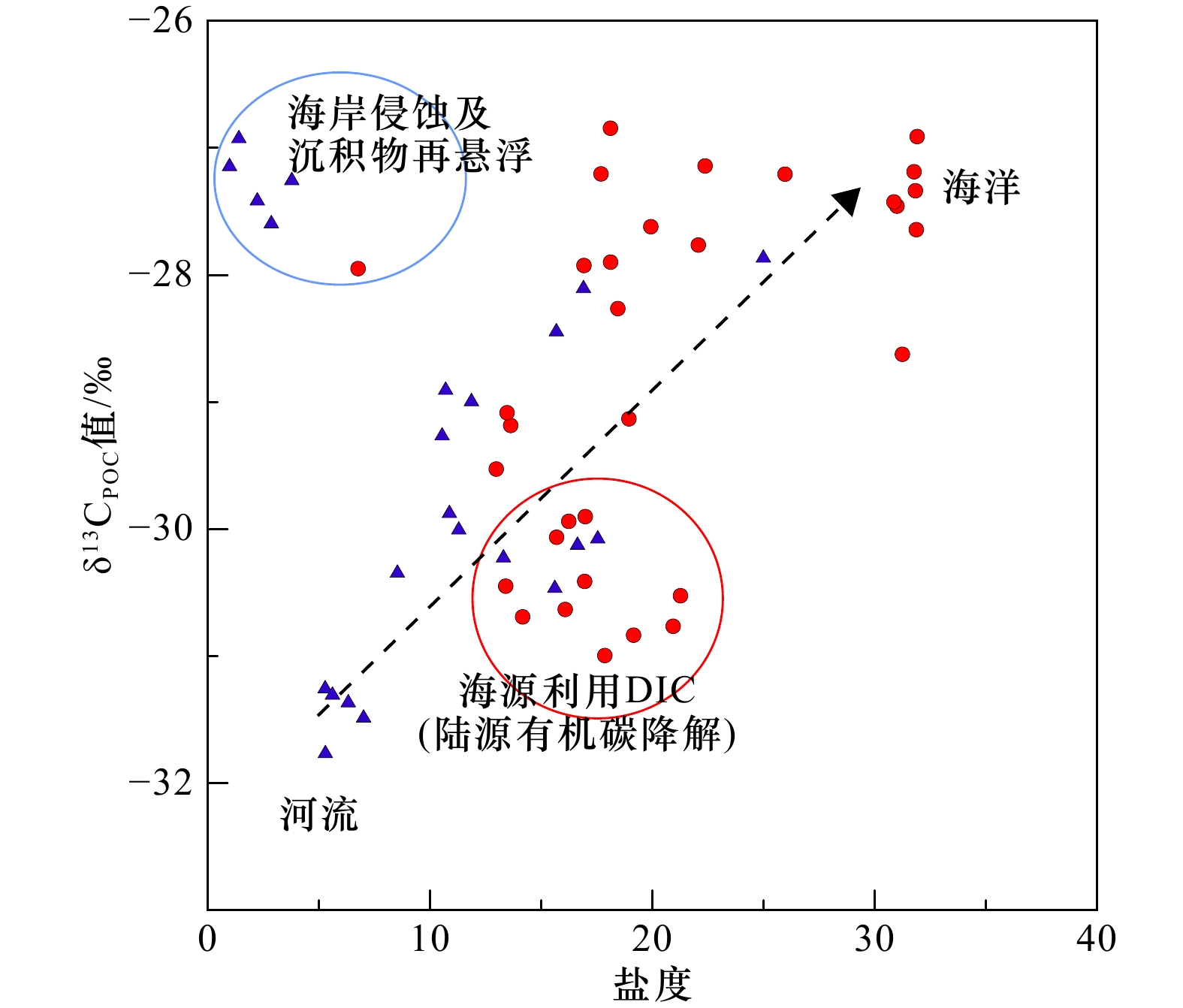Distribution and source of particulate organic carbon in the Arctic Laptev Sea during late summer and early fall
-
摘要: 随着全球变暖的加剧,北极陆架边缘海碳的源汇过程对全球碳循环的影响及其气候环境效应日益显著。拉普捷夫海作为北冰洋典型的陆架边缘海,在大河、海冰、海洋初级生产力及海岸侵蚀的影响下,该区沉积有机碳的来源、输运和埋藏等过程独具特色。本文基于2018年中俄第二次北极联合科考获得的悬浮颗粒物样品和水文资料,研究了夏末秋初拉普捷夫海颗粒有机碳的分布特征、来源及其影响因素。结果表明,颗粒有机碳(POC)的浓度位于35.27~1 185.58 μg/L之间,平均为172.65 μg/L。受河流输入、海岸侵蚀和海洋初级生产力的影响,表层POC浓度分布呈现近岸高、远岸低趋势;底层POC浓度分布主要受控于沉积再悬浮作用,高浓度POC出现在勒拿河三角洲的东部区域。总悬浮颗粒物浓度与POC浓度总体呈显著正相关,显示出其对POC空间分布的直接影响,且两者在底层中的相关性要高于表层,表明不同层位的POC可能存在来源差异。研究区POC的δ13C值处于−31.03‰~−25.79‰之间,表层δ13C值较底层明显偏负,且部分站位的δ13C值甚至低于周边陆源有机碳的端元,这反映了可能除陆源输入的贡献外,近海浮游植物直接利用大量陆源有机质降解产生的溶解无机碳的过程也对该区域POC的供应和来源解析具有重要的影响。Abstract: With the intensification of global warming, the source sink process of carbon in the Arctic shelf-edge sea is becoming more and more important in the study of global carbon cycle. As a typical continental shelf marginal sea in the Arctic Ocean, the source, transportation and burial of sedimentary organic carbon in this area are unique under the influence of rivers, sea ice, marine primary productivity and coastal erosion. Based on the sampling of suspended particulate matter (SPM) and hydrological data obtained from the second Sino-Russian Arctic joint expedition during late summer and early fall in 2018, we foucus on the distribution characteristics, sources and influencing factors of particulate organic carbon (POC) in the Laptev Sea. The results show that POC ranges from 35.27 μg/L to 1 185.58 μg/L, with an average of 172.65 μg/L. Under the effect of river input, coastal erosion and marine primary productivity, the distribution of surface POC shows a decreased trend from near shore towards offshore; the bottom POC is mainly controlled by sediments resuspension, and the high content of POC appears in the east of Lena River Delta. There was a significant positive correlation between SPM concentration and POC concentration, indicating its direct impact on the occurrence of POC; a more positive relation is found among the bottom layer samples, which may indicate the varied origin of POC in different layers. The value of δ13CPOC in study area value is between −31.03‰ and −25.79‰, and the value of δ13C in surface layers is obviously depleted compared with the bottom layer, which is even lower than the end-member of the surrounding terrestrial contributor, suggesting that these POC is not derived from land-based origin. The utilization of the terrestrial POC degraded dissolved inorganic carbon by offshore phytoplankton maybe responsible for this depletion of δ13C offshore, which could also be an important process on the supply and source apportionment of POC in this Arctic coastal area.
-
Key words:
- Arctic; Laptev Sea /
- particulate organic carbon /
- total suspended solids /
- source /
- terrigenous input
-
图 9 拉普捷夫海、东西伯利亚海表层POC的δ13C值和盐度的散点图
图中红色数据点为研究区表层数据(本文);紫色数据点为拉普捷夫海和部分东西伯利亚海表层数据[25]
Fig. 9 The scatter plot of δ13CPOC and salinity in the Laptev Sea and East Siberian Sea surface layer
The red data points in the figure are the surface data of the study area (this paper); the purple data points are the surface data of Laptev Sea and East Siberian Sea [25]
表 1 不同海域海水中POC的浓度
Tab. 1 The concentrations of POC in different oceanic areas
海区 采样时间 POC浓度/(μg·L−1) 资料来源 勒拿河口 2018年9−10月 141.06~1 185.58 本文 拉普捷夫海陆架 2018年9−10月 35.27~104.07 本文 东西伯利亚海陆架 2018年9−10月 57.80~243.90 本文 东西伯利亚海 2016年8−9月 13.15~453.27 文献[32] 拉普捷夫海陆架 2014年7−8月 38.00~138.00 文献[33] 布奥尔哈亚湾及
拉普捷夫海陆架2008年8−9月 18.00~1 850.40 文献[25] 楚科奇海 2012年7−9月 60.93~466.60 文献[34] 喀拉海 2007年9月 6.30~2 404.70 文献[35] 东西伯利亚海陆架 2018年9−10月 57.80~243.90 本文 长江口及其东海陆架 2015年11月 650.00~8 250.00 文献[36] 黄河口及莱州湾 2012年9月 42.25~1 018.87 文献[37] -
[1] Siegenthaler U, Sarmiento J L. Atmospheric carbon dioxide and the ocean[J]. Nature, 1993, 365(6442): 119−125. doi: 10.1038/365119a0 [2] 张海波, 杨鲁宁, 王丽莎, 等. 2013年夏季黄、渤海颗粒有机碳分布及来源分析[J]. 海洋学报, 2016, 38(8): 24−35.Zhang Haibo, Yang Luning, Wang Lisha, et al. Distribution and source analyses of particulate organic carbon in the Yellow Sea and Bohai Sea during summer, 2013[J]. Haiyang Xuebao, 2016, 38(8): 24−35. [3] Stocker T, Plattner G K, Dahe Q. IPCC climate change 2013: the physical science basis-findings and lessons learned[C]//Proceedings of the EGU General Assembly Conference. London: EGU, 2014. [4] Li Mingxu, Peng Changhui, Wang Meng, et al. The carbon flux of global rivers: A re-evaluation of amount and spatial patterns[J]. Ecological Indicators, 2017, 80: 40−51. doi: 10.1016/j.ecolind.2017.04.049 [5] Ludwig W, Probst J L, Kempe S. Predicting the oceanic input of organic carbon by continental erosion[J]. Global Biogeochemical Cycles, 1996, 10(1): 23−41. doi: 10.1029/95GB02925 [6] Blair N E, Aller R C. The fate of terrestrial organic carbon in the marine environment[J]. Annual Review of Marine Science, 2012, 4(1): 401−423. doi: 10.1146/annurev-marine-120709-142717 [7] 王雪景, 金春洁, 王丽莎, 等. 2016年夏季黄、渤海颗粒有机碳的分布特征及影响因素[J]. 海洋学报, 2018, 40(10): 200−208.Wang Xuejing, Jin Chunjie, Wang Lisha, et al. Distribution characteristics and influencing factors of particulate organic carbon in the Yellow Sea and the Bohai Sea in summer of 2016[J]. Haiyang Xuebao, 2018, 40(10): 200−208. [8] McKee B A, Aller R C, Allison M A, et al. Transport and transformation of dissolved and particulate materials on continental margins influenced by major rivers: benthic boundary layer and seabed processes[J]. Continental Shelf Research, 2004, 24(7/8): 899−926. [9] Regnier P, Friedlingstein P, Ciais P, et al. Anthropogenic perturbation of the carbon fluxes from land to ocean[J]. Nature Geoscience, 2013, 6(8): 597−607. doi: 10.1038/ngeo1830 [10] 陈建芳, 金海燕, 李宏亮, 等. 北极快速变化对北冰洋碳汇机制和过程的影响[J]. 科学通报, 2015, 60(35): 3406−3416.Chen Jianfang, Jin Haiyan, Li Hongliang, et al. Carbon sink mechanism and processes in the Arctic Ocean under arctic rapid change[J]. Science Bulletin, 2015, 60(35): 3406−3416. [11] Walsh J J. Arctic carbon sinks: Present and future[J]. Global Biogeochemical Cycles, 1989, 3(4): 393−411. doi: 10.1029/GB003i004p00393 [12] Parmentier F J W, Christensen T R, Sørensen L L, et al. The impact of lower sea-ice extent on Arctic greenhouse-gas exchange[J]. Nature Climate Change, 2013, 3(3): 195−202. doi: 10.1038/nclimate1784 [13] Bruhwiler L, Parmentier F, Crill P, et al. The arctic carbon cycle and its response to changing climate[J]. Current Climate Change Reports, 2021, 7(1): 14−34. doi: 10.1007/s40641-020-00169-5 [14] Stein R, Macdonald R W. Organic carbon budget: Arctic Ocean vs. global ocean[M]//Stein R, MacDonald R W. The Organic Carbon Cycle in the Arctic Ocean. Berlin: Springer, 2004. [15] Stein R, MacDonald R W. The Organic Carbon Cycle in the Arctic Ocean[M]. Berlin: Springer, 2004. [16] 胡利民, 石学法, 叶君, 等. 北极东西伯利亚陆架沉积有机碳的源汇过程研究进展[J]. 地球科学进展, 2020, 35(10): 1073−1086.Hu Limin, Shi Xuefa, Ye Jun, et al. Advances in the sources and sink of sedimentary organic carbon in the East Siberian Arctic Shelf[J]. Advances in Earth Science, 2020, 35(10): 1073−1086. [17] Bianchi T S, Cui Xingqian, Blair N E, et al. Centers of organic carbon burial and oxidation at the land-ocean interface[J]. Organic Geochemistry, 2018, 115: 138−155. doi: 10.1016/j.orggeochem.2017.09.008 [18] Macdonald R W, Kuzyk Z Z A, Johannessen S C. The vulnerability of Arctic Shelf sediments to climate change[J]. Environmental Reviews, 2015, 23(4): 461−479. doi: 10.1139/er-2015-0040 [19] Stein R, Fahl K. The Laptev Sea: distribution, sources, variability and burial of organic carbon[M]//Stein R, Macdonald R W. The Organic Carbon Cycle in the Arctic Ocean. Berlin: Springer, 2004: 213−237. [20] Kassens H, Hubberten H W, Pryamikov S M, et al. Russian-German Cooperation in the Siberian Shelf Seas: Geo-System Laptev Sea[M]. Bremen : Alfred-Wegener-Institut für Polar- und Meeresforschung, 1994. [21] Dmitrenko I A, Tyshko K N, Kirillov S A, et al. Impact of flaw polynyas on the hydrography of the Laptev Sea[J]. Global and Planetary Change, 2005, 48(1/3): 9−27. [22] Tremblay J E, Gratton Y, Fauchot J, et al. Climatic and oceanic forcing of new, net, and diatom production in the North Water[J]. Deep-Sea Research Part II: Topical Studies in Oceanography, 2002, 49(22/23): 4927−4946. [23] Arrigo K R. Chapter 7 physical control of primary productivity in Arctic and Antarctic polynyas[J]. Elsevier Oceanography, 2007, 74: 223−238. [24] Semiletov I, Dudarev O, Luchin V, et al. The East Siberian Sea as a transition zone between pacific-derived waters and Arctic Shelf waters[J]. Geophysical Research Letters, 2005, 32(10): L10614. doi: 10.1029/2005GL022490 [25] Alling V, Porcelli D, Mörth C, et al. Degradation of terrestrial organic carbon, primary production and out-gassing of CO2 along the Laptev and East Siberian seas as inferred from δ13C values of DIC[C]//EGU General Assembly 2012. Vienna, Austria: EGU, 2012. [26] Vonk J E, Sánchez-García L, Van Dongen B E, et al. Activation of old carbon by erosion of coastal and subsea permafrost in Arctic Siberia[J]. Nature, 2012, 489(7414): 137−140. doi: 10.1038/nature11392 [27] Semiletov I P, Pipko I I, Shakhova N E, et al. Carbon transport by the Lena River from its headwaters to the Arctic Ocean, with emphasis on fluvial input of terrestrial particulate organic carbon vs. carbon transport by coastal erosion[J]. Biogeosciences, 2011, 8(9): 2407−2426. doi: 10.5194/bg-8-2407-2011 [28] Grigoriev M N, Rachold V, Schirrmeister L, et al. Organic carbon input to the Arctic seas through coastal erosion[M]//Stein R, Macdonald R W. The Organic Carbon Cycle in the Arctic: Present and Past. Berlin: Springer, 2004: 41−45. [29] Boucsein B, Stein R. Particulate organic matter in surface sediments of the Laptev Sea (Arctic Ocean): application of maceral analysis as organic-carbon-source indicator[J]. Marine Geology, 2000, 162(2/4): 573−586. [30] Sánchez-García L, Alling V, Pugach S, et al. Inventories and behavior of particulate organic carbon in the Laptev and East Siberian seas[J]. Global Biogeochemical Cycles, 2011, 25(2): GB2007. [31] Karlsson E S, Charkin A, Dudarev O, et al. Carbon isotopes and lipid biomarker investigation of sources, transport and degradation of terrestrial organic matter in the Buor-Khaya Bay, SE Laptev Sea[J]. Biogeosciences, 2011, 8(7): 1865−1879. doi: 10.5194/bg-8-1865-2011 [32] Jia Renming, Mu Xinyue, Chen Min, et al. Sources of particulate organic matter in the Chukchi and Siberian shelves: clues from carbon and nitrogen isotopes[J]. Acta Oceanologica Sinica, 2020, 39(9): 96−108. doi: 10.1007/s13131-020-1650-9 [33] Salvadó J A, Tesi T, Sundbom M, et al. Contrasting composition of terrigenous organic matter in the dissolved, particulate and sedimentary organic carbon pools on the outer East Siberian Arctic Shelf[J]. Biogeosciences, 2016, 13(22): 6121−6138. doi: 10.5194/bg-13-6121-2016 [34] 于晓果, 雷吉江, 姚旭莹, 等. 楚科奇海表层海水颗粒物组成与来源[J]. 极地研究, 2014, 26(1): 89−97.Yu Xiaoguo, Lei Jijiang, Yao Xuying, et al. The composition and sources of suspended particles of in the Chukchi Sea and the central Arctic Ocean[J]. Chinese Journal of Polar Research, 2014, 26(1): 89−97. [35] Belyaev N A, Peresypkin V I, Ponyaev M S. The organic carbon in the water, the particulate matter, and the upper layer of the bottom sediments of the West Kara Sea[J]. Oceanology, 2010, 50(5): 706−715. doi: 10.1134/S0001437010050085 [36] 张珊珊, 线薇微, 梁翠. 2015年秋季长江口有机碳的分布特征及其影响因素[J]. 海洋环境科学, 2018, 37(1): 55−61.Zhang Shanshan, Xian Weiwei, Liang Cui. Distribution characteristics of total organic carbon and influence factors in the Yangtze River Estuary in autumn 2015[J]. Marine Environmental Science, 2018, 37(1): 55−61. [37] 白亚之, 刘季花, 胡利民, 等. 2012年秋季黄河口及莱州湾颗粒有机碳的地球化学特征及其影响因素[J]. 地球化学, 2016, 45(5): 462−474. doi: 10.3969/j.issn.0379-1726.2016.05.003Bai Yazhi, Liu Jihua, Hu Limin, et al. Study on the geochemical characteristics of particulate organic carbon and its controlling factors in the Yellow River Estuary and the Laizhou Bay in autumn, 2012[J]. Geochimica, 2016, 45(5): 462−474. doi: 10.3969/j.issn.0379-1726.2016.05.003 [38] Tesi T, Semiletov I, Hugelius G, et al. Composition and fate of terrigenous organic matter along the Arctic land-ocean continuum in East Siberia: Insights from biomarkers and carbon isotopes[J]. Geochimica et Cosmochimica Acta, 2014, 133: 235−256. doi: 10.1016/j.gca.2014.02.045 [39] Van Leussen W. Aggregation of particles, settling velocity of mud flocs a review[M]//Dronkers J, Van Leussen W. Physical Processes in Estuaries. Berlin: Springer, 1988. [40] Gebhardt A C, Gaye-Haake B, Unger D, et al. Recent particulate organic carbon and total suspended matter fluxes from the Ob and Yenisei rivers into the Kara Sea (Siberia)[J]. Marine Geology, 2004, 207(1/4): 225−245. [41] Semiletov I P, Pipko I I, Shakhova N E, et al. On the biogeochemical signature of the Lena River from its headwaters to the Arctic Ocean[J]. Biogeosciences Discussions, 2011, 8(2): 2093−2143. [42] Zhang S, Gan W B, Ittekkot V. Organic matter in large turbid rivers: the Huanghe and its estuary[J]. Marine Chemistry, 1992, 38(1/2): 53−68. [43] 高全洲, 沈承德, 孙彦敏, 等. 北江流域有机碳侵蚀通量的初步研究[J]. 环境科学, 2001, 22(2): 12−18. doi: 10.3321/j.issn:0250-3301.2001.02.003Gao Quanzhou, Shen Chengde, Sun Yanmin, et al. A preliminary study on the organic carbon weathering fluxes in Bei-Jiang River drainage[J]. Environmental Science, 2001, 22(2): 12−18. doi: 10.3321/j.issn:0250-3301.2001.02.003 [44] Redfield A C, Ketchum B H, Richards F A. The influence of organisms on the composition of the sea water[M]//Hill M N. The Sea. New York: Interscience Publishers, 1963: 26−77. [45] Rachold V, Grigoriev M N, Are F E, et al. Coastal erosion vs riverine sediment discharge in the Arctic Shelf seas[J]. International Journal of Earth Sciences, 2000, 89(3): 450−460. doi: 10.1007/s005310000113 [46] Rachold V, Grigoriev M N, Bauch H. An estimation of the sediment budget in the Laptev Sea during the last 5 000 years[J]. Polarforschung, 2002, 70(1): 151−157. [47] Eicken H, Reimnitz E, Alexandrov V, et al. Sea-ice processes in the Laptev Sea and their importance for sediment export[J]. Continental Shelf Research, 1997, 17(2): 205−233. doi: 10.1016/S0278-4343(96)00024-6 [48] Gordeev V V, Martin J M, Sidorov I S, et al. A reassessment of the Eurasian River input of water, sediment, major elements, and nutrients to the Arctic Ocean[J]. American Journal of Science, 1996, 296(6): 664−691. doi: 10.2475/ajs.296.6.664 [49] Romankevich E A, Vetrov A A, Vinogradov M E, et al. Carbon cycling components in the Arctic seas of Russia: Carbon fluxes from land, carbon in the bottom sediments, elements of balance[J]. Oceanology, 2000, 40(3): 335−344. [50] Dethleff D, Nuernberg D, Reimnitz E, et al. East Siberian Arctic Region Expedition '92: the Laptev Sea-Its Significance for Arctic Sea Ice Formation and Transpolar Sediment Flux[M]. Bremen : Alfred-Wegener-Institut für Polar- und Meeresforschung, 1993, 120: 3−37. [51] Eicken H, Kolatschek J, Freitag J, et al. A key source area and constraints on entrainment for basin-scale sediment transport by Arctic sea ice[J]. Geophysical Research Letters, 2000, 27(13): 1919−1922. doi: 10.1029/1999GL011132 [52] Osterkamp T E, Gosink J P. Observations and analyses of sediment-laden sea ice[M]//Barnes P W, Schell D M, Reimnitz E. The Alskan Beaufort Sea: Ecosystems and Environments. Orlando: Academic Press, 1984. [53] Reimnitz E, Barnes P W, Weber W S. Particulate matter in pack ice of the Beaufort Gyre[J]. Journal of Glaciology, 1993, 39(131): 186−198. doi: 10.1017/S0022143000015823 [54] Meyers P A. Organic geochemical proxies of paleoceanographic, paleolimnologic, and paleoclimatic processes[J]. Organic Geochemistry, 1997, 27(5/6): 213−250. [55] Lobbes J M, Fitznar H P, Kattner G. Biogeochemical characteristics of dissolved and particulate organic matter in Russian rivers entering the Arctic Ocean[J]. Geochimica et Cosmochimica Acta, 2000, 64(17): 2973−2983. doi: 10.1016/S0016-7037(00)00409-9 [56] Kutscher L, Mörth C M, Porcelli D, et al. Spatial variation in concentration and sources of organic carbon in the Lena River, Siberia[J]. Journal of Geophysical Research: Biogeosciences, 2017, 122(8): 1999−2016. doi: 10.1002/2017JG003858 [57] McClelland J W, Holmes R M, Peterson B J, et al. Development of a pan-arctic database for river chemistry[J]. Eos, Transactions American Geophysical Union, 2008, 89(24): 217−218. [58] McClelland J W, Holmes R M, Peterson B J, et al. Particulate organic carbon and nitrogen export from major Arctic rivers[J]. Global Biogeochemical Cycles, 2016, 30(5): 629−643. doi: 10.1002/2015GB005351 [59] Martiny A C, Vrugt J A, Primeau F W, et al. Regional variation in the particulate organic carbon to nitrogen ratio in the surface ocean[J]. Global Biogeochemical Cycles, 2013, 27(3): 723−731. doi: 10.1002/gbc.20061 [60] Cauwet G, Sidorov I. The biogeochemistry of Lena River: organic carbon and nutrients distribution[J]. Marine Chemistry, 1996, 53(3/4): 211−227. [61] Semiletov I P, Dudarev O, Pipko I I, et al. Transport and fate of terrestrial organic carbon in the East Siberian land-shelf system: Riverine input vs. coastal erosion[J]. Biogeosciences, 2010, 8: 2407−2426. [62] Rachold V, Eicken H, Gordeev V V, et al. Modern terrigenous organic carbon input to the Arctic Ocean[M]//Stein R, MacDonald R W. The Organic Carbon Cycle in the Arctic Ocean. Berlin: Springer, 2004. [63] Karlsson E S, Charkin A, Dudarev O, et al. Carbon isotopes and lipid biomarker investigation of sources, transport and degradation of terrestrial organic matter in the Buor-Khaya Bay, SE Laptev Sea[J]. Biogeosciences Discussions, 2011, 8(8): 3463−3496. [64] Tarnocai C, Canadell J G, Schuur E A G, et al. Soil organic carbon pools in the northern circumpolar permafrost region[J]. Global Biogeochemical Cycles, 2009, 23(2): GB2023. [65] Rivkina E, Gilichinsky D, Wagener S, et al. Biogeochemical activity of anaerobic microorganisms from buried permafrost sediments[J]. Geomicrobiology Journal, 1998, 15(3): 187−193. doi: 10.1080/01490459809378075 [66] Tesi T, Semiletov I, Dudarev O, et al. Matrix association effects on hydrodynamic sorting and degradation of terrestrial organic matter during cross-shelf transport in the Laptev and East Siberian Shelf seas[J]. Journal of Geophysical Research: Biogeosciences, 2016, 121(3): 731−752. doi: 10.1002/2015JG003067 [67] Comiso J C, Meier W N, Gersten R. Variability and trends in the Arctic sea ice cover: Results from different techniques[J]. Journal of Geophysical Research: Oceans, 2017, 122(8): 6883−6900. doi: 10.1002/2017JC012768 [68] Kinnard C, Zdanowicz C M, Fisher D A, et al. Reconstructed changes in Arctic sea ice over the past 1, 450 years[J]. Nature, 2011, 479(7374): 509−512. doi: 10.1038/nature10581 [69] Boetius A, Albrecht S, Bakker K, et al. Export of algal biomass from the melting Arctic sea ice[J]. Science, 2013, 339(6126): 1430−1432. doi: 10.1126/science.1231346 [70] Pesant S, Legendre L, Gosselin M, et al. Size-differential regimes of phytoplankton production in the Northeast Water Polynya (77°−81°N)[J]. Marine Ecology Progress Series, 1996, 142(1/3): 75−86. [71] 魏皓, 赵伟, 罗晓凡, 等. 北冰洋浮游生物空间分布及其季节变化的模拟[J]. 海洋学报, 2019, 41(9): 65−79.Wei Hao, Zhao Wei, Luo Xiaofan, et al. Simulation of spatial distribution and seasonal variation of plankton in the Arctic Ocean[J]. Haiyang Xuebao, 2019, 41(9): 65−79. [72] Tremblay J É, Michel C, Hobson K A, et al. Bloom dynamics in early opening waters of the Arctic Ocean[J]. Limnology and Oceanography, 2006, 51(2): 900−912. doi: 10.4319/lo.2006.51.2.0900 [73] Müller P J. CN ratios in Pacific deep-sea sediments: Effect of inorganic ammonium and organic nitrogen compounds sorbed by clays[J]. Geochimica et Cosmochimica Acta, 1977, 41(6): 765−776. doi: 10.1016/0016-7037(77)90047-3 [74] Cronin G, Lodge D M. Effects of light and nutrient availability on the growth, allocation, carbon/nitrogen balance, phenolic chemistry, and resistance to herbivory of two freshwater macrophytes[J]. Oecologia, 2003, 137(1): 32−41. doi: 10.1007/s00442-003-1315-3 [75] Martiny A C, Pham C T A, Primeau F W, et al. Strong latitudinal patterns in the elemental ratios of marine plankton and organic matter[J]. Nature Geoscience, 2013, 6(4): 279−283. doi: 10.1038/ngeo1757 [76] Nagel B, Gaye B, Kodina L A, et al. Stable carbon and nitrogen isotopes as indicators for organic matter sources in the Kara Sea[J]. Marine Geology, 2009, 266(1/4): 42−51. -





 下载:
下载:








